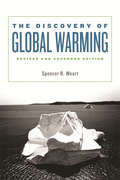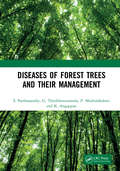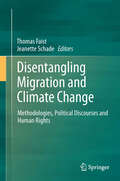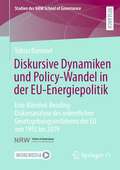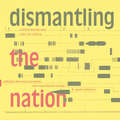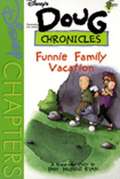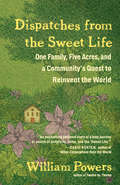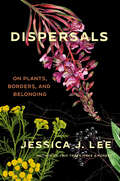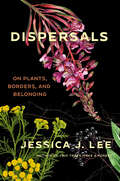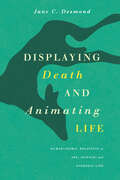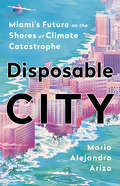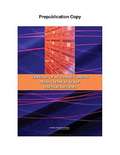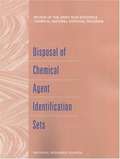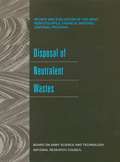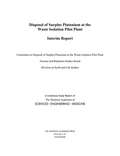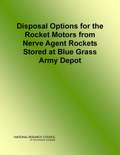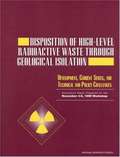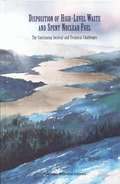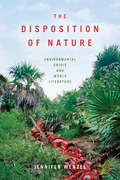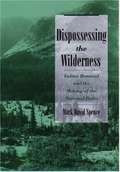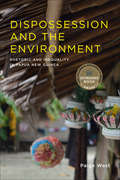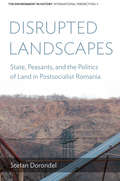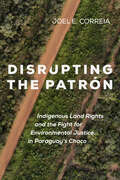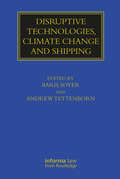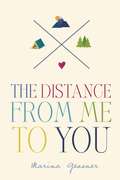- Table View
- List View
The Discovery of Global Warming: Revised and Expanded Edition (New histories of science, technology, and medicine #13)
by Spencer R. WeartThe award-winning book is now revised and expanded. In 2001 an international panel of distinguished climate scientists announced that the world was warming at a rate without precedent during at least the last ten millennia, and that warming was caused by the buildup of greenhouse gases from human activity. The story of how scientists reached that conclusion—by way of unexpected twists and turns—was the story Spencer Weart told in The Discovery of Global Warming. Now he brings his award-winning account up to date, revised throughout to reflect the latest science and with a new conclusion that shows how the scientific consensus caught fire among the general world public, and how a new understanding of the human meaning of climate change spurred individuals and governments to action.
Diseases of Forest Trees and their Management
by S. Parthasarathy G. Thiribhuvanamala P. Muthulakshmi K. AngappanThe book is intended to provide comprehensive introduction to the important aspects of the field of forest pathology and tree diseases. The book is arranged in two major parts. The fundamental chapters, present forest diseases, pathogens, epidemics, and management that is applicable to all forest trees. The applied chapters on the individual crops that are grouped alphabetically present information on the symptoms, pathogen and integrated management of major diseases of forest trees. It was designed to give a broad overview of the field of forest pathology but with sufficient detail that they will be able to assess their specific role as practicing forestry professionals.Note: T& F does not sell or distribute the Hardback in India, Pakistan, Nepal, Bhutan, Bangladesh and Sri Lanka.
Disentangling Migration and Climate Change: Methodologies, Political Discourses and Human Rights
by Jeanette Schade Thomas FaistThis book addresses environmental and climate change induced migration from the vantage point of migration studies, offering a broad spectrum of approaches for considering the environment/climate/migration nexus. Research on the subject is still frequently narrowed down to climate change vulnerability and the environmental push factor. The book establishes the interconnections between societal and environmental vulnerability, and migration and capability, allowing appreciation of migration in the frame of climate as a case of spatial and social mobility, that is, as a strategy of persons and groups to deal with a grossly unequal distribution of life chances across the world. In their introduction, the editors fan out the current debate and state the need to transcend predominantly policy-oriented approaches to migration. The first section of the volume focuses on "Methodologies and Methods" and presents very distinct approaches to think climate induced migration. Subsequent chapters explore the sensitivity of existing migration flows to climate change in Ghana and Bangladesh, the complex relationship between migration, demographic change and coping capacities in Canada, methodological challenges of a household survey on the significance of migration and remittances for adaptation in the Hindu Kush region and an econometric study of the aftermath of the 1998 floods in Bangladesh. The second part, "Areas of Concern: Politics and Human Rights", deepens the analysis of discourses as well as of the implications of proposed and implemented policies. Contributors discuss such topics as environmental migration as a multi-causal problem, climate migration as a consequence in an alarmist discourse and climate migration as a solution. A study of an integrated relocation program in Papua New Guinea is followed by chapters on the promise and the flaws of planned relocation policy, global policy on protection of environmental migrants including both internally displaced peoples and those who cross international borders. A concluding chapter places human agency at centre stage and explores the interplay between human rights, capability and migration.
Diskursive Dynamiken und Policy-Wandel in der EU-Energiepolitik: Eine Blended-Reading-Diskursanalyse des ordentlichen Gesetzgebungsverfahrens der EU von 1992 bis 2019 (Studien der NRW School of Governance)
by Tobias RammelWie lässt sich Policy-Wandel in der Europäischen Union erklären? Tobias Rammel beantwortet diese Frage erstmals für die Gesamtheit des ordentlichen Gesetzgebungsverfahrens zur EU-Energiepolitik von 1992 bis 2019 im Rahmen einer Blended-Reading-Diskursanalyse. Rekurrierend auf eine Analyse des Forschungsstandes zur EU-Energiepolitik wird in diesem Buch argumentiert, dass eine theoretische Synthese der Arbeiten zur Diskursanalyse und zum Policy-Wandel die bisherigen Defizite der klassischen Theorieschulen ausgleichen kann. Methodisch wird in einem innovativen dreistufigen Forschungsdesign auf eine Blended-Reading-Kombination von Close-Reading in Form von unüberwachten Text-Mining-Verfahren (Topic Modeling) zur induktiv-explorativen Vorstrukturierung der Analyse und Distant-Reading in Form einer qualitativen Feinanalyse zur Interpretation und Kontextualisierung der Daten zurückgegriffen. Damit liefert das Buch eine bislang einzigartige und differenzierte Erklärung für Policy-Wandel und die dazugehörigen diskursiven Dynamiken zwischen den EU-Institutionen im COD der EU-Energiepolitik von 1992 bis 2019.
Dismantling the Nation: Contemporary Art in Chile
by Florencia San MartínThe first volume to theorize and historicize contemporary artistic practices from Chile in the English language, Dismantling the Nation begins from a position of radical criticism against the nation-state of Chile and its capitalist, heteronormative, and extractivist rule. At a truly pivotal moment in the country’s history, when it is redefining what it wants to be, the works here propose a way of forging a feminist and decolonial future for Chile. The authors attend to practices from distinct locations in Chile, reconceptualizing geographical borders from a transnational and transdisciplinary perspective while engaging with ecocriticism and Indigenous epistemologies. This is an essential volume for anyone looking to understand the current social, political, and artistic movements in Chile.
Disney's Doug Chronicles: The Funnie Family Vacation - Book #10
by Pam Muñoz RyanDoug is sure his summer is completely doomed when he has to go on a week-long camping trip with his entire family. To top it all off, he has to miss Beebe's annual swim party.
Dispatches from the Sweet Life: One Family, Five Acres, and a Community's Quest to Reinvent the World
by William PowersMany fantasize about dramatically changing their lives — living in accordance with their ideals rather than the exigencies of job, bills, and possessions. William Powers actually does it. In his book Twelve by Twelve, Powers lived in an off-grid tiny house in rural North Carolina. In New Slow City, he and his wife, Melissa, inhabited a Manhattan micro-apartment in search of slow in the fastest city in the world. Here, the couple, with baby in tow, search for balance, community, and happiness in a small town in Bolivia. They build an adobe house, plant a prolific orchard and organic garden, and weave their life into a community of permaculturists, bio-builders, artists, and creative businesspeople. Can this Transition Town succeed in the face of encroaching North American capitalism, and can Powers and the other settlers find the balance they’re seeking? Dispatches from the Sweet Life is compelling, sobering, thought-provoking, and, no matter the outcome, inspiring.
Dispersals: On Plants, Borders, and Belonging
by Jessica J. LeeA prize-winning memoirist and nature writer turns to the lives of plants entangled in our human world to explore belonging, displacement, identity, and the truths of our shared futureA seed slips beyond a garden wall. A tree is planted on a precarious border. A shrub is stolen from its culture and its land. What happens when these plants leave their original homes and put down roots elsewhere?In fourteen essays, Dispersals explores the entanglements of the plant and human worlds: from species considered invasive, like giant hogweed; to those vilified but intimate, like soy; and those like kelp, on which our futures depend. Each of the plants considered in this collection are somehow perceived as being &‘out of place&’—weeds, samples collected through imperial science, crops introduced and transformed by our hand. Combining memoir, history, and scientific research in poetic prose, Jessica J. Lee meditates on the question of how both plants and people come to belong, why both cross borders, and how our futures are more entwined than we might imagine.
Dispersals: On Plants, Borders, and Belonging
by Jessica J. LeeINSTANT TORONTO STAR BESTSELLERThe prize-winning and bestselling author of Two Trees Make a Forest turns to the lives of plants entangled in our human world to explore belonging, displacement, identity, and the truths of our shared futureA seed slips beyond a garden wall. A tree is planted on a precarious border. A shrub is stolen from its culture and its land. What happens when these plants leave their original homes and put down roots elsewhere?The themes in these fourteen essays become invigorating and intimate in Lee&’s hands, centering on the lives of plants like seaweed, tangelos, and soy, and their entanglement with our human worlds. Lee explores the rich backstory of cherry trees in Berlin; a tea plant that grows in the Himalayan foothills just southwest of China; the world of algae and wakame, and the journeys they&’ve made to reach us.Each of the plants considered in this collection are somehow perceived as being &“out of place&”—weeds, samples collected through imperial science, crops introduced and transformed by our hand. Lee looks at these plant species in their own context, even when we find them outside of it.Dispersals draws a gorgeous, sprawling map of the diaspora of flora. Combining memoir, history, and scientific research in poetic prose, Jessica J. Lee meditates on the question of how both plants and people come to belong, why both cross borders, and how our futures are more entwined than we might imagine.
Displaying Death and Animating Life: Human-Animal Relations in Art, Science, and Everyday Life (Animal Lives Ser.)
by Jane C. DesmondThe number of ways in which humans interact with animals is almost incalculable. From beloved household pets to the steak on our dinner tables, the fur in our closets to the Babar books on our shelves, taxidermy exhibits to local zoos, humans have complex, deep, and dependent relationships with the animals in our ecosystems. In Displaying Death and Animating Life, Jane C. Desmond puts those human-animal relationships under a multidisciplinary lens, focusing on the less obvious, and revealing the individualities and subjectivities of the real animals in our everyday lives. Desmond, a pioneer in the field of animal studies, builds the book on a number of case studies. She conducts research on-site at major museums, taxidermy conventions, pet cemeteries, and even at a professional conference for writers of obituaries. She goes behind the scenes at zoos, wildlife clinics, and meetings of pet cemetery professionals. We journey with her as she meets Kanzi, the bonobo artist, and a host of other animal-artists--all of whom are preparing their artwork for auction. Throughout, Desmond moves from a consideration of the visual display of unindividuated animals, to mourning for known animals, and finally to the marketing of artwork by individual animals. The first book in the new Animal Lives series, Displaying Death and Animating Life is a landmark study, bridging disciplines and reaching across divisions from the humanities and social sciences to chart new territories of investigation.
Disposable City: Miami's Future on the Shores of Climate Catastrophe
by Mario Alejandro ArizaA deeply-reported personal investigation by a Miami journalist into the present and future effects of climate change in the Magic City-a watery harbinger for coastal cities worldwide.Miami, Florida, is likely to be entirely underwater by the end of this century. Residents are already starting to see the effects of sea level rise today. From sunny day flooding caused by higher tides to a sewer system on the brink of total collapse, the city undeniably lives in a climate changed world. In Disposable City, Miami resident Mario Alejandro Ariza shows us not only what climate change looks like on the ground today, but also what Miami will look like 100 years from now, and how that future has been shaped by the city's racist past and present. As politicians continue to kick the can down the road and Miami becomes increasingly unlivable, real estate vultures and wealthy residents will be able to get out or move to higher ground, but the most vulnerable communities, disproportionately composed of people of color, will face flood damage, rising housing costs, dangerously higher temperatures, and stronger hurricanes that they can't afford to escape. Miami may be on the front lines of climate change, but the battle it's fighting today is coming for the rest of the U.S.--and the rest of the world--far sooner than we could have imagined even a decade ago. Disposable City is a thoughtful portrait of both a vibrant city with a unique culture and the social, economic, and psychic costs of climate change that call us to act before it's too late.
Disposal of Activated Carbon from Chemical Agent Disposal Facilities
by National Research Council of the National AcademiesFor the last two decades, the United States has been destroying its entire stockpile of chemical agents. At the facilities where these agents are being destroyed, effluent gas streams pass through large activated carbon filters before venting to ensure that any residual trace vapors of chemical agents and other pollutants do not escape into the atmosphere in exceedance of regulatory limits. All the carbon will have to be disposed of for final closure of these facilities to take place. In March 2008, the Chemical Materials Agency asked the National Research Council to study, evaluate, and recommend the best methods for proper and safe disposal of the used carbon from the operational disposal facilities. This volume examines various approaches to handling carbon waste streams from the four operating chemical agent disposal facilities. The approaches that will be used at each facility will ultimately be chosen bearing in mind local regulatory practices, facility design and operations, and the characteristics of agent inventories, along with other factors such as public involvement regarding facility operations.
Disposal of Chemical Agent Identification Sets: Review of the Army Non-Stockpile Chemical Material Disposal Program
by National Research CouncilThe National Academies Press (NAP)--publisher for the National Academies--publishes more than 200 books a year offering the most authoritative views, definitive information, and groundbreaking recommendations on a wide range of topics in science, engineering, and health. Our books are unique in that they are authored by the nation's leading experts in every scientific field.
Disposal of Neutralent Wastes
by Board on Army Science Technology National Research CouncilInformation on the Disposal of Neutralent Wastes
Disposal of Surplus Plutonium at the Waste Isolation Pilot Plant: Interim Report
by Engineering Medicine National Academies of SciencesDisposal of Surplus Plutonium at the Waste Isolation Pilot Plant: Interim Report evaluates the general viability of the U.S. Department of Energy’s National Nuclear Security Administration’s (DOE-NNSA’s) conceptual plans for disposing of 34 metric tons (MT) of surplus plutonium in the Waste Isolation Pilot Plant (WIPP), a deep geologic repository near Carlsbad, New Mexico. This report evaluates DOE-NNSA’s plans to ship, receive, and emplace surplus plutonium in WIPP and its understanding of the impacts of these plans on WIPP and WIPP-bound waste streams. This report, the first of two to be issued during this study, provides a preliminary assessment of the general viability of DOE-NNSA’s conceptual plans, focusing on some of the barriers to their implementation.
Disposal Options for the Rocket Motors From Nerve Agent Rockets Stored at Blue Grass Army Depot
by Division on Engineering and Physical Sciences Committee on Disposal Options for the Rocket Motors of Nerve Agent Rockets at Blue Grass Army Depot National Research Council Board on Army Science and TechnologyThe Blue Grass Chemical Agent-Destruction Pilot Plant (BGCAPP) is under construction near Richmond, Kentucky, two dispose of one of the two remaining stockpiles of chemical munitions in the United States. The stockpile that BGCAPP will dispose of is stored at the Blue Grass Army Depot (BGAD). BGCAPP is a tenant activity on BGAD. The stockpile stored at BGAD consists of mustard agent loaded in projectiles, and the nerve agents GB and VX loaded into projectiles and M55 rockets. BGCAPP will process the rockets by cutting them, still in their shipping and firing tube (SFT), between the warhead and motor sections of the rocket. The warhead will be processed through BGCAPP. The separated rocket motors that have been monitored for chemical agent and cleared for transportation outside of BGCAPP, the subject of this report, will be disposed of outside of BGCAPP. Any motors found to be contaminated with chemical agent will be processed through BGCAPP and are not addressed in this report. Disposal Options for the Rocket Motors From Nerve Agent Rockets Stored at Blue Grass Army Depot addresses safety in handling the separated rocket motors with special attention to the electrical ignition system, the need for adequate storage space for the motors in order to maintain the planned disposal rate at BGCAPP, thermal and chemical disposal technologies, and on-site and off-site disposal options. On-site is defined as disposal on BGAD, and off-site is defined as disposal by a commercial or government facility outside of BGAD.
Disposition of High-Level Radioactive Waste through Geological Isolation: Development, Current Status, and Technical and Policy Challenges
by Steering CommitteeThe National Academies Press (NAP)--publisher for the National Academies--publishes more than 200 books a year offering the most authoritative views, definitive information, and groundbreaking recommendations on a wide range of topics in science, engineering, and health. Our books are unique in that they are authored by the nation's leading experts in every scientific field.
Disposition of High-level Waste and Spent Nuclear Fuel: The Continuing Societal and Technical Challenges
by National Research CouncilFocused attention by world leaders is needed to address the substantial challenges posed by disposal of spent nuclear fuel from reactors and high-level radioactive waste from processing such fuel. The biggest challenges in achieving safe and secure storage and permanent waste disposal are societal, although technical challenges remain. Disposition of radioactive wastes in a deep geological repository is a sound approach as long as it progresses through a stepwise decision-making process that takes advantage of technical advances, public participation, and international cooperation. Written for concerned citizens as well as policymakers, this book was sponsored by the U.S. Department of Energy, U.S. Nuclear Regulatory Commission, and waste management organizations in eight other countries.
The Disposition of Nature: Environmental Crisis and World Literature
by Jennifer WenzelHow do literature and other cultural forms shape how we imagine the planet, for better or worse? In this rich, original, and long awaited book, Jennifer Wenzel tackles the formal innovations, rhetorical appeals, and sociological imbrications of world literature that might help us confront unevenly distributed environmental crises, including global warming.The Disposition of Nature argues that assumptions about what nature is are at stake in conflicts over how it is inhabited or used. Both environmental discourse and world literature scholarship tend to confuse parts and wholes. Working with writing and film from Africa, South Asia, and beyond, Wenzel takes a contrapuntal approach to sites and subjects dispersed across space and time. Reading for the planet, Wenzel shows, means reading from near to there: across experiential divides, between specific sites, at more than one scale.Impressive in its disciplinary breadth, Wenzel’s book fuses insights from political ecology, geography, anthropology, history, and law, while drawing on active debates between postcolonial theory and world literature, as well as scholarship on the Anthropocene and the material turn. In doing so, the book shows the importance of the literary to environmental thought and practice, elaborating how a supple understanding of cultural imagination and narrative logics can foster more robust accounts of global inequality and energize movements for justice and livable futures.
Dispossessing the Wilderness: Indian Removal and the Making of the National Parks
by Mark David SpenceNational parks like Yellowstone, Yosemite, and Glacier preserve some of this country's most cherished wilderness landscapes. While visions of pristine, uninhabited nature led to the creation of these parks, they also inspired policies of Indian removal. By contrasting the native histories of these places with the links between Indian policy developments and preservationist efforts, this work examines the complex origins of the national parks and the troubling consequences of the American wilderness ideal. The first study to place national park history within the context of the early reservation era, it details the ways that national parks developed into one of the most important arenas of contention between native peoples and non-Indians in the twentieth century.
Dispossession and the Environment: Rhetoric and Inequality in Papua New Guinea (Leonard Hastings Schoff Lectures)
by Paige WestWhen journalists, developers, surf tourists, and conservation NGOs cast Papua New Guineans as living in a prior nature and prior culture, they devalue their knowledge and practice, facilitating their dispossession. Paige West's searing study reveals how a range of actors produce and reinforce inequalities in today's globalized world. She shows how racist rhetorics of representation underlie all uneven patterns of development and seeks a more robust understanding of the ideological work that capital requires for constant regeneration.
Disrupted Landscapes: State, Peasants and the Politics of Land in Postsocialist Romania
by Stefan DorondelThe fall of the Soviet Union was a transformative event for the national political economies of Eastern Europe, leading not only to new regimes of ownership and development but to dramatic changes in the natural world itself. This painstakingly researched volume focuses on the emblematic case of postsocialist Romania, in which the transition from collectivization to privatization profoundly reshaped the nation's forests, farmlands, and rivers. From bureaucrats abetting illegal deforestation to peasants opposing government agricultural policies, it reveals the social and political mechanisms by which neoliberalism was introduced into the Romanian landscape.
Disrupting the Patrón: Indigenous Land Rights and the Fight for Environmental Justice in Paraguay's Chaco
by Joel E. CorreiaA free ebook version of this title is available through Luminos, University of California Press’s Open Access publishing program. Visit www.luminosoa.org to learn more. In Paraguay’s Chaco region, cattle ranching drives some of the world’s fastest deforestation and most extreme inequality in land tenure, with grave impacts on Indigenous well‑being. Disrupting the Patrón traces Enxet and Sanapaná struggles to reclaim their ancestral lands from the cattle ranches where they labored as peons—a decades-long resistance that led to the Inter‑American Court of Human Rights and back to the frontlines of Paraguay’s ranching frontier. The Indigenous communities at the heart of this story employ a dialectics of disruption by working with and against the law to unsettle enduring racial geographies and rebuild territorial relations, albeit with uncertain outcomes. Joel E. Correia shows that Enxet and Sanapaná peoples enact environmental justice otherwise: moving beyond juridical solutions to harm by maintaining collective lifeways and resistance amid radical social-ecological change. Correia’s ethnography advances debates about environmental racism, ethics of engaged research, and Indigenous resurgence on Latin America’s settler frontiers.
Disruptive Technologies, Climate Change and Shipping (Maritime and Transport Law Library)
by Bariş Soyer Andrew Tettenborn Simon BaughenThis book analyses the impact of two vital and contemporary developments on shipping law and practice: disruptive technologies and climate change. It considers the impact of these new technologies, honing in on likely emerging issues and unresolved questions, especially about existing and potential private law liabilities and concentrates, from the point of view of English, EU and international law, on the legal implications of climate change and associated environmental risks in the shipping sector. Written by a contributor team drawn from the most experienced and knowledgeable academics and practitioners in shipping law, this treatment of these growing areas of practice will be of great use to lawyers and administrators across the world.
The Distance from Me to You
by Marina GessnerWild meets Endless Love in this multilayered story of love, survival, and self-discoveryMcKenna Berney is a lucky girl. She has a loving family and has been accepted to college for the fall. But McKenna has a different goal in mind: much to the chagrin of her parents, she defers her college acceptance to hike the Appalachian Trail from Maine to Georgia with her best friend. And when her friend backs out, McKenna is determined to go through with the dangerous trip on her own. While on the Trail, she meets Sam. Having skipped out on an abusive dad and quit school, Sam has found a brief respite on the Trail, where everyone's a drifter, at least temporarily.Despite lives headed in opposite directions, McKenna and Sam fall in love on an emotionally charged journey of dizzying highs and devastating lows. When their punch-drunk love leads them off the trail, McKenna has to persevere in a way she never thought possible to beat the odds or risk both their lives.
